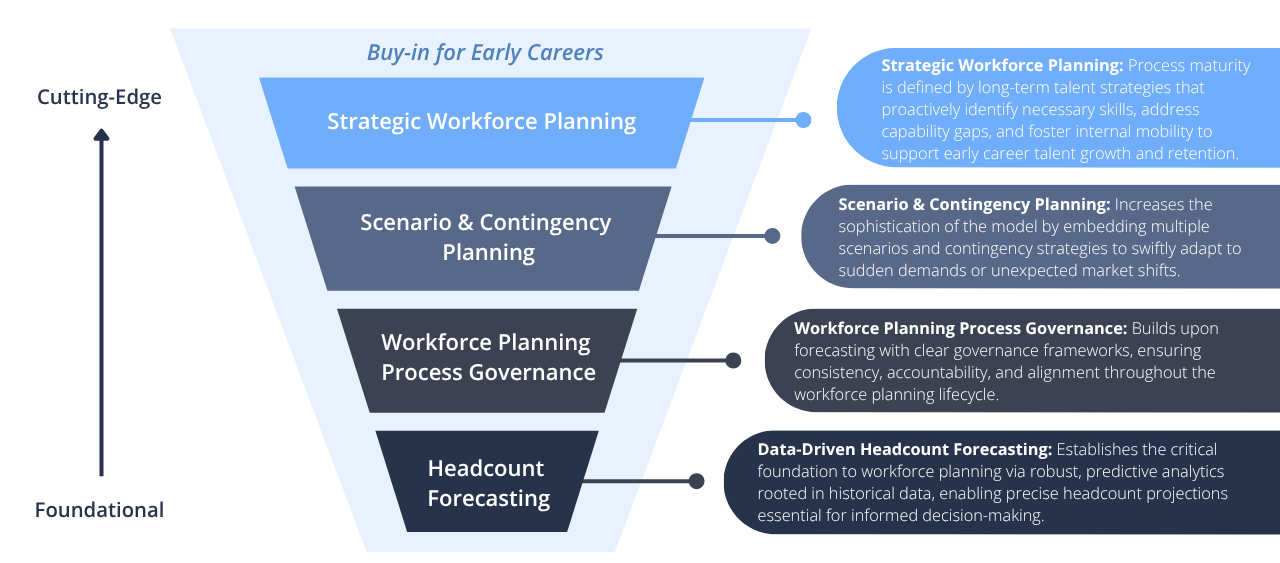Solving Workforce Planning
Workforce planning in early careers is one of the hardest challenges in recruiting today. Not a single University Recruiting leader we’ve spoken to feels confident in their current system, and we have yet to find an organization that’s cracked the code.
At Veris Insights, we know the scale of the workforce planning challenge. And we think it’s worth trying to solve anyway.


Our Roadmap to Solving Workforce Planning
From validating the challenge to launching your complete solution suite, follow our journey—rigorous research, real-world insights, and iterative innovation every step of the way.
The Pitfalls of Reactive Workforce Planning
79% of UR leaders say workforce planning is a 2025 priority, but most struggle to make real progress. The biggest hurdle? No clear, repeatable process for headcount planning. From intake to approvals, every step requires buy-in, and UR often fights just to be included in a process that’s barely defined.
Missed Hiring Targets
Full-time needs go unmet, leading to under-resourced teams and costly, last-minute hiring. Over-hiring, meanwhile, wastes budget and dilutes intern ROI.
Loss of Top Talent
Strong candidates fall through the cracks and accept competitor offers, costing companies high-potential future employees.
Wasted Budget & Lower ROI
Misaligned intern programs consume time and resources without building strong full-time pipelines.
Why this Challenge Can’t Wait
Workforce planning in early careers can no longer be aspirational–it’s essential. Done right, it can be a strategic lever for transformation.
Rising Pressure on UR to Prove ROI
With enterprise-wide budget scrutiny intensifying, UR teams must demonstrate the business value of every hire. Leaders are being asked to justify headcount and program spend with clear outcomes, such as cost-per-hire reductions, conversion success, and retention improvements—rather than historical precedent or gut feel.
A Volatile, Unpredictable Market
Economic uncertainty, shifting business strategies, and evolving hiring timelines make long-term headcount planning more fragile than ever. Traditional, one-time planning models are no longer sufficient. UR teams must be prepared to adjust quickly when priorities shift or requisitions are cut mid-cycle.
AI Is Reshaping Entry-Level Roles
The rise of generative AI is transforming both the structure of work and the skill sets needed in entry-level roles. Forecasting models must now account for AI-readiness, training investments, and new eligibility criteria as baseline technical expectations shift. For UR, this represents both a challenge and a chance to lead in preparing the future workforce.

Strategic forecasting isn’t just about filling roles—it’s about achieving critical business outcomes. Align your workforce planning with measurable results, such as improved intern-to-full-time conversions, cost efficiency, and enhanced retention.
Our Best-in-Class Workforce Planning Model
Our approach to UR workforce planning is grounded in data-driven, iterative forecasting. It’s a four-part, connected process that builds on itself: driving alignment, earning stakeholder trust, and positioning early career talent as a strategic lever for long-term goals.

Get Involved & Shape the Research
Join our mission to solve one of the greatest challenges in Early Career Recruiting.

Donate Data
Opt in for Employer Benchmarking & get exclusive access to the full report.

Share Your Insights
Have you cracked the code? Have a challenge to inform the work? Let us know, and get early insights to refine your strategy.
Stages of Workforce Maturity
Different levels of workforce planning maturity come with different obstacles. Explore the Four Stages of Workforce Planning Maturity to start mapping which solutions will resonate with your program.
“We’re always putting out fires and rarely have visibility into hiring needs beyond the next requisition.”
Key Characteristics
- Reactive, ad-hoc hiring without structured processes
- No defined framework or tools for forecasting
- Minimal understanding of strategic value
Core Challenges
- Misalignment and unclear role of University Recruiting
- Lack of data and metrics to demonstrate ROI
- No formal headcount approval process
What’s Your Workforce Planning Stage?
Take our quick, 1-minute quiz to pinpoint where your program stands.
🟥 Stage 1: Nascent
“We’re constantly reacting and never ahead of the curve.”
UR operates in fire-drill mode with no structured forecasting, limited visibility, and low credibility across the business.
🟧 Stage 2: Foundational
“We’ve started to plan, but it still feels like guesswork.”
Some early forecasting efforts exist, but they’re inconsistent, manual, and rarely influence upstream decisions.
🟨 Stage 3: Established
“We have a system, it works, but it can’t flex quickly.”
Forecasting is standardized and tied to hiring, but struggles to adapt to sudden shifts or enable agile scenario planning.
🟩 Stage 4: Cutting Edge
“We’re a strategic partner; our forecasts shape business decisions.”
UR drives proactive, data-backed planning in partnership with the business, using robust tools and multi-year forecasting.